 and follow this:
and follow this:FAM - Floating Angle Model
The general idea of FAM is: we are looking for sensitive degrees. For example, instead of stating something like this "When Mars ingresses Libra or when Mars passes 15 degrees of Aries, something happens to the stock market", we do it easier: we analyze what happens to the stock market when Mars passes 1st, 2nd ... 360th degree of Zodiac. In other words, instead of assuming that some degree is special, we quickly analyze all degrees and know for sure that that one is special. Or another example: "When Mars passes the 8th house of the Natal chart of company X, something happens to the shares of this company". Here you might come across a problem: somebody else might have a different Natal chart for the same company X. You can waste your time arguing what chart is true - without FAM model. With FAM model, you have no problem at all. There is no problem, because from the point of view of FAM model this statement actually sounds as: "When Mars passes some zones of Zodiac, something happens ...". We do not care about "true" Natal chart of this company, we may even not knowing its Natal chart at all; for us it is enough to know the physical fact that something happens with the price of the shares of this company when Mars passes some specific zones of Zodiac. You can read about this approach here: http://www.timingsolution.com/TS/Study/FAM/index.htm
One more example when FAM helps you is the statement like that one: "when we have the TRINE (120 degrees) aspect between the Sun and Jupiter, something happens ...". You may encounter the arguments like "when the angle separation between the Sun and Jupiter reaches 120 degrees (this is one half of TRINE aspect, TRINE takes place when the angle separation reaches 120 or 240 degrees), something happens" (a correction of what is the trine) or: "When the angle separation reaches 108 degrees, something happens ..." (the exact number of degrees is disputed).
With FAM model you have no need to worry about what angle really works on the stock market, as you can analyze how the stock market reacts to each and every angle separation between chosen planets.
Now let me demonstrate how to apply FAM model in Timing Solution.
Neural Network module
You can define FAM model here  and follow this:
and follow this:
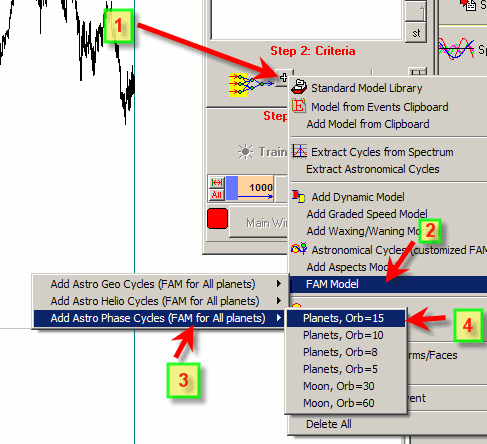
If you choose the Planets, Orb=15, the program analyzes each 15th degree of Zodiac and observes the stock market's reactions when planets pass these 15 degrees segments.
You can also define the FAM model more flexible choosing this item:
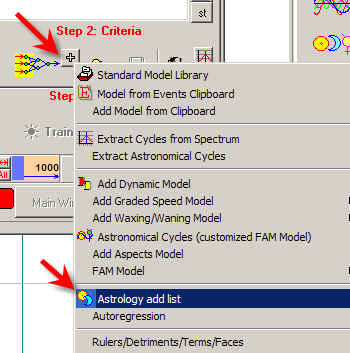
You will get this dialog box:

The most important parameter here is Step. In this particular case I set it as 8 degrees. It means that the whole Zodiac will be divided on 45 equal segments, 8 degrees each segment; the program will analyze how each segment impacts the stock market when some planet passes through this segment. Try different variants: 15 degrees (i.e 24 segments), 10 degrees (36 segments).
Also ![]() parameters are very important. When "Position" is ON, the
program creates the list of events for planetary positions in different segments
of Zodiac. When "Aspects between Planets" is ON, the program creates
the list of events to analyze active degrees between the planets. For example, if
you need to create the forecast model based on sensitive
angles between the Sun and Jupiter with the step=5 degrees, set these parameters and
click
parameters are very important. When "Position" is ON, the
program creates the list of events for planetary positions in different segments
of Zodiac. When "Aspects between Planets" is ON, the program creates
the list of events to analyze active degrees between the planets. For example, if
you need to create the forecast model based on sensitive
angles between the Sun and Jupiter with the step=5 degrees, set these parameters and
click ![]() button:
button:
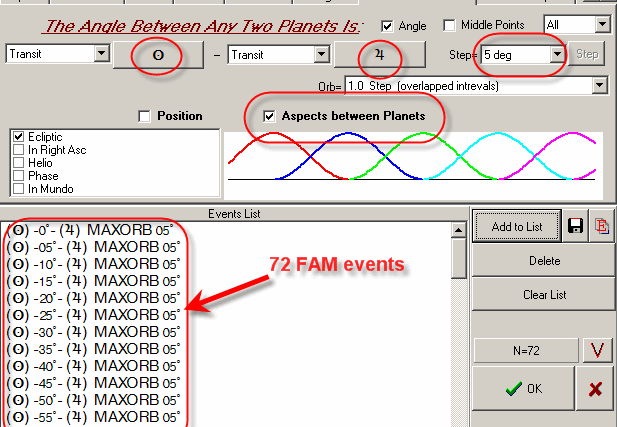
The program will create the list of 72 FAM events analyzing each 5-degrees sector of the angle between the Sun and Jupiter.
If you want to create the FAM model for the angle between the Sun and other planets (except the Moon), fill out this form:

There is another possibility- FAM-2 model. You can define FAM-2 model here:

As FAM model, it analyses the active degrees though it uses a bit different math approach more suitable for Neural Network technology:
Making mouse double-click here, you can choose any astronomical cycle:
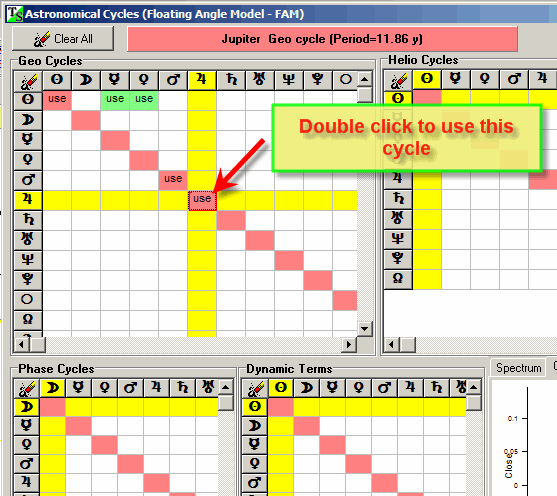
Diagonal elements (say Sun-Sun cell) correspond to the pure Sun cycle, while non diagonal elements (say Mars-Venus) correspond to the angle between planets (the Sun-Venus angle in our example).
The only important parameter here is H; it is the amount of overtones:
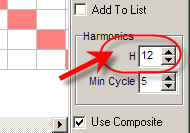
The more overtones you set, the more detailed projection line you will get (though it will be noisy). The same is for Step parameter in regular FAM model. I recommend to start with a bigger step, say 15 degrees; then look at your projection line - if it is not noisy/jumpy try to decrease step to 10 degrees. The same is for H parameter in FAM-2 model, try to set it 6-12. If te projection line is good, you can increase it to 18-20.
.
Upcoming Events module
You can find FAM in "Upcoming Events" module as well:

Also you can define FAM module manually here:

The FAM model can be applied for other modules in Timing Solution, like Bradley Barometer, Turning Points astro indicators and other. It is very helpful in cases where initial statement regarding astro events and their impact on the stock market is not clear or is disputable. It does a research and creates a model at the same time.